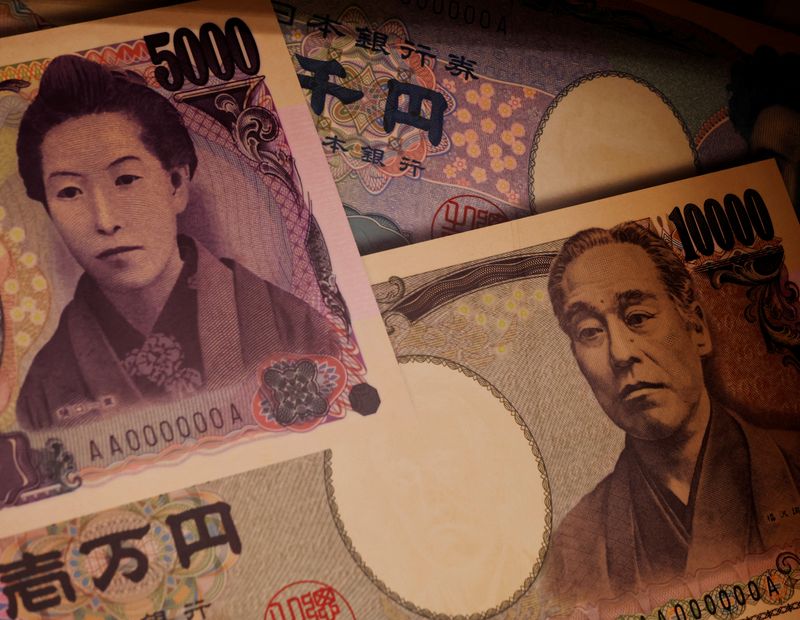By Gertrude Chavez-Dreyfuss
NEW YORK (Reuters) -The safe-haven Swiss franc and Japanese yen pared gains on Friday after Tehran signaled it has no plans to retaliate against Israel, which launched what has been described as a limited-scale attack on Iran overnight.
Both currencies jumped against their peers after news of Israel’s action, but their gains have slowed.
In afternoon trading, the dollar fell 0.2% against the Swiss franc to 0.91 franc. It dropped as low as 0.9011 franc overnight, a roughly two-week low, following news of Israel’s move.
Against the yen, the dollar was last slightly down at 154.57 yen. The greenback slid as low as 153.59 yen after Israel’s news.
Iranian media and officials described a small number of explosions, which they said resulted from air defenses hitting three drones over the city of Isfahan in central Iran. A senior Iranian official told Reuters there were no plans to respond against Israel for the incident.
“The market initially reacted poorly because of the premise of an Israel response,” said Eugene Epstein, head of structuring for North America at Moneycorp in New Jersey.
“The question is: does this conflict drag out? At the moment, Iran’s response to Israel is interpreted as a de-escalation, for now. Therefore we have seen a reversal of pretty much everything.”
People familiar with the matter told Reuters that Israel attacked Iran days after Iran launched an unprecedented assault on Israel in response to a suspected Israeli strike on its consulate in Syria.
Markets initially reacted sharply to the news of the latest Israel initiative, which sparked a sell-off in risk assets, caused oil and gold prices to jump, and ignited a rally in U.S. Treasuries and safe-haven currencies.
The , which tracks the currency against six major peers, also rose but gave up its gains to stand little changed on the day at 106.17.
Currencies bounced around throughout the European and North American sessions, with the euro initially falling, but was flat at $1.0648 in late-afternoon trading. Sterling fell 0.5% to $1.2370.
The broad theme of the last few weeks has been a surging dollar on the back of a strong U.S. economy. The euro has been down 1.3% so far this month, while sterling has fallen 2%.
Hot data, especially figures last week showing inflation rose to 3.5% in March, has caused traders to rapidly downsize their bets on Federal Reserve interest rate cuts this year to fewer than rate cuts, most likely starting in September. That has caused U.S. bond yields to spike, boosting the to its highest since November earlier this week.
“Investors are still focused on the Fed mainly, instead of geopolitics,” said Boris Kovacevic, global market strategist at Convera in Vienna, Austria. “The broader, bigger picture is the higher for longer theme in the U.S. rates.”
Asian currencies have come under particular pressure, and finance chiefs in the United States, Japan and South Korea this week issued a rare trilateral warning over the two Asian nations’ sliding exchange rates, raising the prospect of a potential joint intervention.
Bank of Japan Governor Kazuo Ueda said on Thursday the central bank may raise interest rates again if the yen’s declines significantly push up inflation, highlighting the impact currency moves may have on the timing of the next policy shift.
The BOJ will hold its monetary policy meeting next week. Data on Friday showed Japanese core inflation slowed to 2.6% year-on-year in March, from 2.8%, but remained above the central bank’s 2% target.
Japanese Finance Minister Shunichi Suzuki on Friday have fresh warnings to speculators about pushing down the yen too much, noting that he would take appropriate action against excessive currency market moves.
In cryptocurrencies, bitcoin rose 1.1% to $64,287 ahead of the widely anticipated halving event either later on Friday or over the weekend. halving refers to a technical adjustment built into the digital currency’s code which reduces the rate at which new coins are created.

